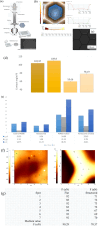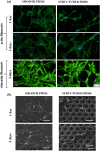PDMS biointerfaces featuring honeycomb-like well microtextures designed for a pro-healing environment
- PMID: 40171285
- PMCID: PMC11959266
- DOI: 10.1039/d5ra00063g
PDMS biointerfaces featuring honeycomb-like well microtextures designed for a pro-healing environment
Abstract
Even today, the reduction of complications following breast implant surgery together with the enhancement of implant integration and performance through the modulation of the foreign body response (FBR), remains a fundamental challenge in the field of plastic surgery. Therefore, tailoring the material's physical characteristics to modulate FBR can represent an effective approach in implantology. While polydimethylsiloxane (PDMS) patterning on 2D substrates is a relatively established and available procedure, micropatterning multiscaled biointerfaces on a controlled large area has been more challenging. Therefore, in the present work, a specific designed honeycomb-like well biointerface was designed and obtained by replication in PDMS at large scale and its effectiveness towards creating a pro-healing environment was investigated. The grayscale masks assisted laser-based 3D texturing method was used for creating the required moulds in Polycarbonate for large area replication. By comparison to the smooth substrate, the honeycomb topography altered the fibroblasts' behaviour in terms of adhesion and morphology and reduced the macrophages' inflammatory response. Additionally, the microstructured surface effectively inhibited macrophage fusion, significantly limiting the colonization of both Gram-positive and Gram-negative microbial strains on the tested surfaces. Overall, this study introduces an innovative approach to mitigate the in vitro FBR to silicone, achieved through the creation of a honeycomb-inspired topography for prosthetic interfaces.
This journal is © The Royal Society of Chemistry.
Conflict of interest statement
There are no conflicts to declare.
Figures








References
-
- Chao A. H. Garza R. Povoski S. P. Expert Rev. Med. Devices. 2016;13:143–156. - PubMed
-
- Plastic Surgery Statistics, American Society of Plastic Surgeons, https://www.plasticsurgery.org/news/plastic-surgery-statistics, accessed 13 October 2023
-
- Albornoz C. R. Bach P. B. Mehrara B. J. Disa J. J. Pusic A. L. McCarthy C. M. Cordeiro P. G. Matros E. Plast. Reconstr. Surg. 2013;131:15–23. - PubMed
LinkOut - more resources
Full Text Sources

